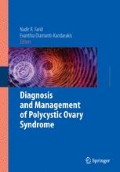The diagnostic conundrum of possible polycystic ovarian syndrome is one frequently encountered in both the primary care setting and in secondary care. As part of the diagnostic work-up, women are often referred for ultrasound. Transabdominal and, more recently, transvaginal ultrasound have become universally used for identification of polycystic ovaries, but for many years, there has been lack of agreement as to the ultrasound diagnostic features. All too often ovaries are described as looking polycystic in the imaging report without reference to the phase of the menstrual cycle, number or size of follicles, or volume of the ovaries. This has led to many women being incorrectly labelled as having polycystic ovaries in the past, without fulfilling any of the now accepted criteria.
Access this chapter
Tax calculation will be finalised at checkout
Purchases are for personal use only
References
The Rotterdam ESHRE/ASRM-sponsored PCOS consensus workshop group. Revised 2003 consensus on diagnostic criteria and longterm health risks related to polycystic ovary syndrome (PCOS). Hum Reprod 2004; 19:41–47.
Stein IF, Leventhal ML. Amenorrhoea associated with bilateral polycystic ovaries. Am J Obstet Gynecol 1935; 29:181–191.
Franks S. Polycystic ovary syndrome: a changing perspective. Clin Endocrinol 1989; 31:87–120.
Conway GS, Honour JW, Jacobs HS. Heterogeneity of the polycystic ovary syndrome: clinical, endocrine and ultrasound features in 556 patients. Clin Endocrinol 1989; 30:459–470.
Polson DW, Adams J, Wadsworth J, Franks S. Polycystic ovaries—a common finding in normal women. Lancet 1988; 1:870–872.
Balen AH, Conway GS, Kaltsas G et al. Polycystic ovary syndrome: the spectrum of the disorder in 1741 patients. Hum Reprod 1995; 10:2107–2111.
Swanson M, Sauerbrei EE, Cooperberg PL. Medical implications of ultrasonically detected polycystic ovaries. J Clin Ultrasound 1981; 9:219–222.
Balen AH, Laven JS, Tan S et al. Ultrasound assessment of the polycystic ovary: international consensus definitions. Human Reproduction Update 2003; 9(6):505–514.
Clayton RN, Ogden V, Hodgkinson J, Worswick L, Rodin DA, Dyer S, et al. How common are polycystic ovaries in normal women and what is their significance for the fertility of the population? Clin Endocrinol 1992;37:127–134.
Dewailly D. Definition and significance of polycystic ovaries in hyperandrogenic states and hirsutism. Ball Clin Obstet Gynecol 1997;11:349–368.
Adams J, Polson DW, Abdulwahid N, Morris DV, Franks S, Mason HD, Tucker M, Price J, Jacobs HS. Multifollicular ovaries: clinical and endocrine features and response to pulsatile gonadotropin releasing hormone. Lancet 1985; 2:1375–1379.
The Royal College of Obstetricians and Gynaecologists. Long-term consequences of polycystic ovary syndrome. Guideline No 33; 2003
Kimura I, Togashi K, Kawakami S, et al. Polycystic ovaries: implications of diagnosis with MR imaging. Radiology 1996; 201:549–52.
Faure N, Bastide A, Lemay A Assessment of ovaries by magnetic resonance imaging in patients presenting with polycystic ovarian syndrome. Hum Reprod 1989; 4:468–472
Author information
Authors and Affiliations
Corresponding author
Editor information
Editors and Affiliations
Rights and permissions
Copyright information
© 2009 Springer Science+Business Media, LLC
About this chapter
Cite this chapter
Barter, S.J. (2009). The Radiology of Polycystic Ovaries. In: Farid, N.R., Diamanti-Kandarakis, E. (eds) Diagnosis and Management of Polycystic Ovary Syndrome. Springer, Boston, MA. https://doi.org/10.1007/978-0-387-09718-3_3
Download citation
DOI: https://doi.org/10.1007/978-0-387-09718-3_3
Published:
Publisher Name: Springer, Boston, MA
Print ISBN: 978-0-387-09717-6
Online ISBN: 978-0-387-09718-3
eBook Packages: MedicineMedicine (R0)

